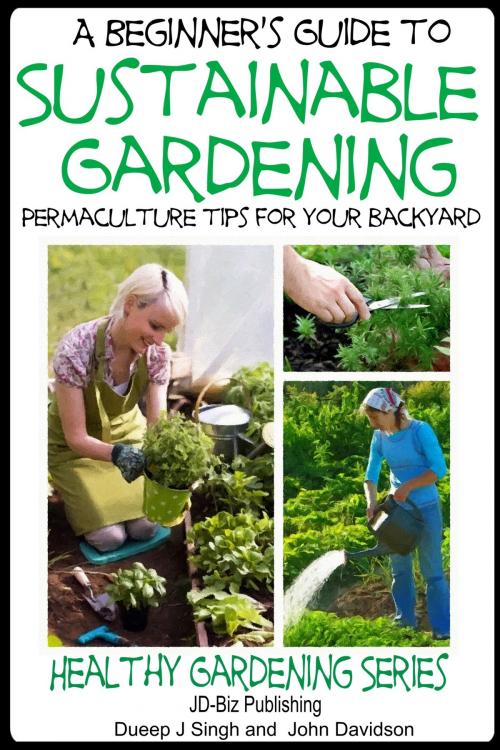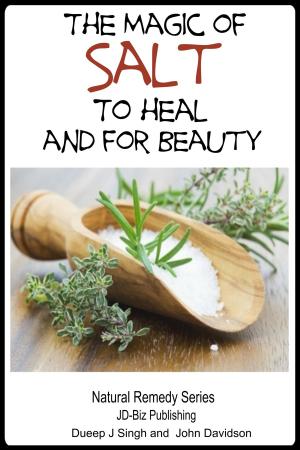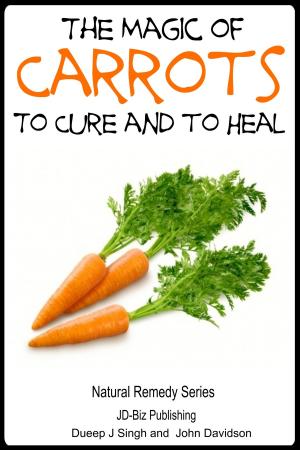| Author: | Dueep Jyot Singh, John Davidson | ISBN: | 9781311544551 |
| Publisher: | JD-Biz Corp Publishing | Publication: | July 30, 2014 |
| Imprint: | Smashwords Edition | Language: | English |
| Author: | Dueep Jyot Singh, John Davidson |
| ISBN: | 9781311544551 |
| Publisher: | JD-Biz Corp Publishing |
| Publication: | July 30, 2014 |
| Imprint: | Smashwords Edition |
| Language: | English |
A Beginner’s Guide to Sustainable Gardening
Table of Contents
Introduction
Important Points of Sustainable Management
Principles of Sustainable Gardening
Some General Talk on Natural Ecosystems and Sustainable Forestry
Water Harvesting
Making Holding Pools
Concrete Pools
How to Make Your Own Pond
Prefabricated Pools.
Miscellaneous Containers
Making Natural Compost
My Best Friends – Earthworms
Using Barnyard Produce for Making Compost
Enriching The Soil with Natural Nutrients
Chemical Fertilizers
Seaweed water fertilizer
More Natural Herbicides
Saving Seeds from Last Year’s Crop
Maintaining your garden
Beneficial Insects for Pest Control
Essential Tools for Your Sustainable Garden
Sustainable Gardening in Limited Spaces
Know about pollinators
Appendix
Desertification control and rangeland management
Leaf Compost
Music of the hills by Saki
Author Bio
Introduction
It was in the 1980s that the word sustainability in regard to an environment began to be associated with nature, environment, agriculture, and thus gardening.
Horticulturalists believing in sustainable agriculture decided that it was easier for humans to use natural resources in a way to get better yields. They have been doing this for millenniums. However, this drain on the natural resources was going to cause the depreciation of such resources one time or the other because mother nature cannot keep nourishing and replenishing her without getting back something of what she gave.
And this gave rise to the concept of sustainable gardening.
Harvesting things you have grown your own self from your garden is such a positive feeling of achievement.
The idea was that use what you can, from nature’s bounty, and then give back to her, what you can so that you and she work in tandem in a symbiotic relationship.
So all of us home gardeners can use sustainable gardening tips to make beautiful gardens with eco friendly designs, use of biodegradable materials, use of organic fertilizer and using native plants to sustain the environment and make a sustainable garden.
A fruitful harvest is a lovesome thing God Wot – 14th-century saying
When I was being taught agronomy at college in the 80s, nobody bothered about sustainable gardening. That was because in the East, the traditional agricultural practices were with the use of natural resources, because the agricultural traditions still belong to the middle 14 century in many parts of the country!
That is why what is considered sustainable and organic gardening in the West today was an integral part of human existence in the Indian subcontinent at that time. We used organic fertilizer. We did not know about chemical pesticides or hormones. On the flipside, we did not know about agricultural development, which was taking place all over the world to get a better yield of food and crops.
And that is why we relied on just the monsoon to feed our crops, and prayed to the rain God. If he did not come on time, we would be sunk. The bank and the money lender would take our land and then there would be no resort but to starve or go to the city to survive or lend ourselves out in bonded labor to a more prosperous farmer.
This may sound shocking to people in well-developed countries, but this is still the sort of existence which is being led by people in many parts of the world. Even today, in this day of state-of-the-art technology and technological development, underdeveloped countries still follow obsolete agricultural practices, which do not take into account the natural resources already around them. And so, famine has been a part of their lives for centuries.
So here are some rules which you are going to implement right now to make sustainable gardening possible.
A Beginner’s Guide to Sustainable Gardening
Table of Contents
Introduction
Important Points of Sustainable Management
Principles of Sustainable Gardening
Some General Talk on Natural Ecosystems and Sustainable Forestry
Water Harvesting
Making Holding Pools
Concrete Pools
How to Make Your Own Pond
Prefabricated Pools.
Miscellaneous Containers
Making Natural Compost
My Best Friends – Earthworms
Using Barnyard Produce for Making Compost
Enriching The Soil with Natural Nutrients
Chemical Fertilizers
Seaweed water fertilizer
More Natural Herbicides
Saving Seeds from Last Year’s Crop
Maintaining your garden
Beneficial Insects for Pest Control
Essential Tools for Your Sustainable Garden
Sustainable Gardening in Limited Spaces
Know about pollinators
Appendix
Desertification control and rangeland management
Leaf Compost
Music of the hills by Saki
Author Bio
Introduction
It was in the 1980s that the word sustainability in regard to an environment began to be associated with nature, environment, agriculture, and thus gardening.
Horticulturalists believing in sustainable agriculture decided that it was easier for humans to use natural resources in a way to get better yields. They have been doing this for millenniums. However, this drain on the natural resources was going to cause the depreciation of such resources one time or the other because mother nature cannot keep nourishing and replenishing her without getting back something of what she gave.
And this gave rise to the concept of sustainable gardening.
Harvesting things you have grown your own self from your garden is such a positive feeling of achievement.
The idea was that use what you can, from nature’s bounty, and then give back to her, what you can so that you and she work in tandem in a symbiotic relationship.
So all of us home gardeners can use sustainable gardening tips to make beautiful gardens with eco friendly designs, use of biodegradable materials, use of organic fertilizer and using native plants to sustain the environment and make a sustainable garden.
A fruitful harvest is a lovesome thing God Wot – 14th-century saying
When I was being taught agronomy at college in the 80s, nobody bothered about sustainable gardening. That was because in the East, the traditional agricultural practices were with the use of natural resources, because the agricultural traditions still belong to the middle 14 century in many parts of the country!
That is why what is considered sustainable and organic gardening in the West today was an integral part of human existence in the Indian subcontinent at that time. We used organic fertilizer. We did not know about chemical pesticides or hormones. On the flipside, we did not know about agricultural development, which was taking place all over the world to get a better yield of food and crops.
And that is why we relied on just the monsoon to feed our crops, and prayed to the rain God. If he did not come on time, we would be sunk. The bank and the money lender would take our land and then there would be no resort but to starve or go to the city to survive or lend ourselves out in bonded labor to a more prosperous farmer.
This may sound shocking to people in well-developed countries, but this is still the sort of existence which is being led by people in many parts of the world. Even today, in this day of state-of-the-art technology and technological development, underdeveloped countries still follow obsolete agricultural practices, which do not take into account the natural resources already around them. And so, famine has been a part of their lives for centuries.
So here are some rules which you are going to implement right now to make sustainable gardening possible.















